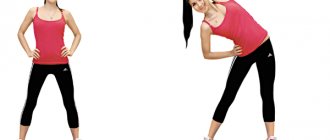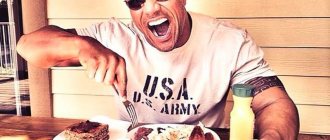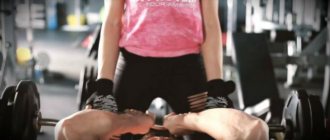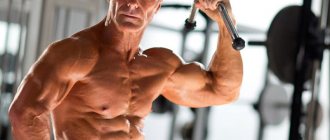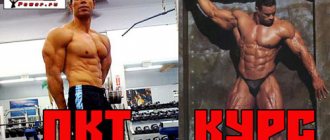Stuart McRobert, a provincial bodybuilding enthusiast, has always advocated healthy sports, without the use of steroids, as well as other artificial drugs. His merit is that he was able to develop his own special training method, thanks to which he made a revolution in the world of bodybuilding. This technique is the basis of all healthy amateur bodybuilding. Unfortunately, without muscle tissue growth activators it is almost impossible to achieve serious results, but it is very possible to form a beautiful body.
Training system
In his book Think!, Stewart described his training system in detail. This book became a bestseller and was published six times, thanks to which the athlete managed to become the founder of amateur bodybuilding. The training scheme is based on the fact that the anthropometric data of the novice athlete is taken into account, so it was possible to select the appropriate set of exercises individually.
According to the author, the age of the athlete plays a decisive role in achieving high results. As he claims, you can always count on significant success, but only until the age of 35.
To select an appropriate training program, it is important to take into account the physical characteristics of the athlete. The calculations are based on 3 main indicators: height - 175 cm, wrist size - 17.5 cm and weight - 76 kg.
For beginning athletes with such parameters, the author of the book recommends the following:
- Squats with a weight of 150 kg.
- Lying barbell lifts weighing 110 kg.
- Bench press - 65 kg.
- Deadlift - 180 kg.
These basic exercises are complemented by several approaches of the following nature:
- 10 approaches - squats with a weight of 120 kg.
- 10 sets - deadlift with a weight of 140 kg.
- 10 approaches - deadlift on straight legs with a weight of 110 kg.
- 6 approaches - bench press, weighing 100 kg.
- 6 approaches - overhead barbell press, weighing 50 kg.
- 8 approaches - biceps curls 40 kg.
- 8 approaches - bench press with a narrow grip, weighing 90 kg.
- 20 times - calf raises, with a weight of 20 kg.
All training must be carried out under normal operating conditions. If you reduce the speed, it will not bring any dividends. When an athlete prefers a slower pace, it is better to reduce the load by removing a little weight.
The individuality of the athlete also plays an important role. In order for muscle definition to appear, you need to constantly increase the load. When you constantly work with the same weights, the muscles get used to the load and stop increasing their volume.
CLIENT DOSSIER
Flynn began to carefully collect information:
— How much do you bench press?
“Five times 55 kg, but I rarely do this,” the guy answered. “I don’t want my arms to be blurred against the background of my chest and shoulders.”
- Clear. What about squats and deadlifts?
- I never do them at all. And then, exercises for the legs and back are very tiring. And I need to save strength for my biceps and triceps!
Then the conversation turned to food. Although nutrition is a strong word: the guy ate almost nothing except some ultra-modern dietary supplement from anabolic-metabolic optineurogranular amino activators.
“If you want to look like a champion, you need to eat like a champion,” the guy explained to Flynn.
“That’s true,” Flynn confirmed with the most serious look.
Supply system
Without proper nutrition, you will not be able to radically change your body. To work with heavy loads, you need a lot of nutrients. Therefore, you will have to eat more and more often. It is not so easy to switch to such a diet overnight. He believes that the main food product is milk. Based on this, it is necessary to consume it constantly so that the body replenishes iron. Naturally, the healthiest thing is natural milk. The same applies to other food products. Therefore, many athletes buy food from markets and prepare it themselves. If an athlete cannot digest lactose, then you can eat low-fat. In any case, milk can be replaced with yoghurts or smoothies based on egg whites.
It is better not to consume products that contain preservatives and various chemicals at all. A bodybuilder's diet should consist of a variety of foods. It is not advisable to eat the same food all the time. To improve your appetite, you can avoid eating altogether for a while. Porridges also need to be alternated, as well as side dishes for them.
It is undesirable to eat fatty foods containing cholesterol. Stuart Mac Robert does not support the initiative, which is aimed at not consuming such products at all. The athlete believes that if he is healthy, then such products can be present in his diet.
If you do not use steroids and lead a healthy lifestyle, then you can safely move away from a strict diet, but you need to know the real load on the liver. To do this, you need to have your blood tested from time to time to check your cholesterol levels. This approach will allow you to realistically assess the benefits of your diet or its harm. As a result, it is realistic to adjust your diet.
The author of the book recommends that all athletes over 35 years of age give up most animal fats, replacing them with seafood, vegetable oil, nuts or seeds. This will lead to a noticeable reduction in blood cholesterol levels. He also claims that conventional low-fat diets are the result of steroids and other chemicals affecting the liver.
Despite the fact that he did not accept classical nutritional patterns, he recommended, especially for beginner athletes, to count their calorie intake. You need to eat the same amount of calories for several weeks in a row, after which you need to find out how much weight you have gained. If all this time your body weight is at the same level, then you will have to add about 300 calories to your diet, but no more. An athlete needs at least 4,000 calories per day. When a positive result appears, the need for such a nutritional plan will disappear by itself.
Movement towards the intended goal should be gradual.
The amount of exercise, as well as calories, should increase gradually. The enhanced nutrition regimen should be accompanied exclusively by the most intense training. It is during these periods that the foundation for the future shape of the athlete’s body is laid. Energy should be directed only towards muscle growth. If fat deposits appear, calories should be cut back, again adjusting your diet.
Stuart Mac Robert points to the fact that appetite is the result of effective training and diet. When after training an athlete becomes tired and has no appetite, it means that either the training was not intense or the athlete is not receiving the necessary nutrients. Typically, such symptoms appear in vegetarians, so their diet must include foods such as milk and eggs.
An hour before starting the training process, you should drink a milkshake that is easily digestible. You should not allow your body to starve; you can still drink a cocktail an hour after training.
NEW DIET
Under Flynn's leadership, the guy buried supplies of his super-supplement in the yard. I wonder if the grass will wither over this grave? - Flynn and I wondered. (As it turned out, it withered). Since then, the only supplement our young friend took was vitamins and minerals. And then one tablet a day. But in general, his diet consisted of natural, high-quality food: eggs, milk, cheese, meat, fish, pasta, bread, potatoes, vegetables and fruits. He ate hearty meals four to five times a day. As soon as I felt hungry, I immediately swallowed something solid. And he washed it down with one or two glasses of milk.
- So, does everyone have to eat like this? - I asked Flynn.
- No, only young and thin. But a man over thirty can limit himself to three meals a day: a good breakfast, a hearty lunch and dinner. The main thing is to eat high-quality, healthy foods. And get all your nutrients from them, not from supplements. As your training gets harder, you also need to eat more to provide your growing body with everything it needs.
Three months later, the guy added 13 kg in the bench press, 18 in the squats and 20 in the deadlift. In addition, he himself gained 4.5 kg - only due to muscles. Flynn told him that things were looking up and it was time to move on to the second phase of the program. But first, ten days of complete rest.
Features of an athlete's life
The legendary athlete was born in the city of Liverpool in 1958. From an early age, he was haunted by the idea of becoming a bodybuilder, so at the age of 14 he began going to the gym. He practiced quite a lot and therefore decided to describe the entire training process. He first did this at the age of 15.
This was not his first work and not his last, so he continued to write articles on the topic of bodybuilding. And only in 1981 his first work was published. In the same year, he managed to release a manual on bodybuilding, which became revolutionary in bodybuilding. After some time, Stuart moved to Cyprus, where he began teaching.
Unfortunately, this athlete was unable to achieve the results shown by professional athletes and ended his professional career. But he began to fight for a healthy lifestyle with the help of articles and books. Thus, he remained an amateur athlete.
In 1989, the athlete began publishing the Hardgainer magazine in his printing house. The magazine was published in large circulations until 2004 and enjoyed enormous success. As a rule, in his works, Stewart argues that any person can make a good amateur athlete.
When developing training systems and diet, he always took the standard data of an ordinary person as a basis. The writer lives in Cyprus with his wife and two daughters, but continues to write, study philosophy and work in the gym.
So a man who could not achieve significant success in sports life was able to become outstanding in bodybuilding. Many aspiring athletes begin their sports careers armed with his books. The merit of Stuart Mac Robert is that he was able to develop his own training system and nutritional plan that allow any person to create a beautiful body, as well as achieve serious success in sports, without any particular risk to health and with minimal consumption of activators.
Super program for gaining weight. Think! Stuart McRobert
Other Bench Press Tips
Apply chalk to your palms to improve your grip and grip on the bar. Keep the fingerboard checkering clean. In this case, your hands will not slide to the edges of the bar during the set.
Never turn your head while raising or lowering the barbell. If you do this, the barbell will tilt slightly to one end, you will “lose” the amplitude and, possibly, get injured.
If you are working in the frame from the bottom point, then before each repetition you should make sure that the bar rests symmetrically on the stops and that the distance between the bar and the vertical posts of the frame is the same on both sides. If necessary, an assistant should correct any imbalance between repetitions. But as you gain experience, if you lower the barbell in a controlled manner, you will be able to learn how to lower the barbell correctly onto the stops on each rep.
In this picture, the athlete is lowering the bar to the upper chest. NEVER DO THIS! Countless athletes have ruined their shoulders forever with this technique.
Using 50% of your maximum weight for a given number of repetitions, do several sets of 10 repetitions, comparing two different barbell lifts. Decide for yourself which trajectory seems more natural and powerful to you. Perhaps, to make a final decision, you will need to conduct more than one training session. Then over the course of a few weeks you should gradually return to your previous best weights. You may need even more time for this if before this your bench press technique was very different from the one I described above. And only after that
You can start conquering new weights and start building muscles.
New, correct technique will increase
your bench press results and
reduce
your chance of injury. But if you rush and return to the same weights too soon, you will ruin your new technique and start injuring yourself again.
Once you have learned a good new bench press technique and learned how to put it into practice, train yourself to prepare for the bench press and approach the barbell in the same and specific way every time. Having loaded the bench press bar, approach it and take your starting position on the bench as usual, but clearly, consistently and seriously. Ask your assistant or partner to watch your bench press from the side or videotape yourself. Please be sure to do this, because perhaps you are doing something wrong, although it seems to you that you are doing everything correctly.
When applying chalk to your hands, cover the entire surface of your palm well, including the area on the inside of your thumb and index finger.
Once you have learned your new correct bench press technique, you still need to be very careful about how you perform that technique on every rep. Never become arrogant and don’t think that even if you are distracted by something else, you are still doing everything technically. Without being 100% focused, you may lower the bar incorrectly or straighten one arm before the other. All this can easily unsettle you, i.e. correct trajectory of movement. The weight will seem overwhelming to you, you will not do the required number of repetitions, you will fall into despair and, possibly, get injured.
McRobert's training program
Option #1
Workout #1
- Romanian deadlift – 1 set of 15 reps and 1 set of 10
- Military press – 1 set of 10 reps and 1 set of 6
- Wide grip pull-ups – 1 set of 12 reps and 1 set of 8
- Dips – 1 set of 10 reps and 1 set of 6
- Calf raises – 2 sets of 20 reps
Workout #2
- Barbell squats – 1 set of 15 reps and 1 set of 10
- Bench press – 1 set of 12 reps and 1 set of 8
- Shrugs – 1 set of 15 reps and 1 set of 10
- Seated dumbbell press – 1 set of 8 reps
- Bent-over barbell row – 1 set of 10 reps and 1 set of 6
- Biceps curls – 1 set of 10 reps and 1 set of 6
Working approaches are performed until “failure”, while you can use 1-2 warm-up approaches to prepare the central nervous system for issuing stronger nerve impulses.
